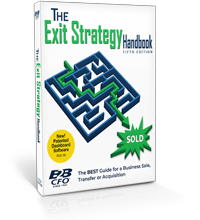
by Ania Kubicki | Feb 15, 2012 | Archives
Jerry Mills strongly believes that in order to get the economy back on track, tax cuts must be given to the small business owners of the...

by Ania Kubicki | Feb 13, 2012 | Archives
BtoB Online By: Reid Carr & Grant Brisacher CMOs have long wrestled with their colleagues in the C-suite for the budget they get to fund their promotion and customer relationship initiatives, and it won’t get any easier for some time. A challenging economic period combined with a pervasive degree of uncertainly about the future will mean every dollar spent must be accounted for properly. The logical move by CMOs is to seek additional capital from less than traditional sources, such as through partner affiliation or vendor accountability. However, one place that is often overlooked is within their own spreadsheets. What they may find is certain portions of their budgets should be on another department’s books. In “finance speak,” there are essentially two different “colors” of money—one classified as operating expenses and the other identified as capital expenses. Operating expenses are the cost of doing business, such as office rent, utilities, supplies, insurance, software, promotions, advertising and professional fees. Capital expenses are newly purchased fixed assets or investments that, while not used for ordinary operations, improve the life of an existing infrastructure and overall productivity. Normally, these include things such as office equipment, computers, ERP systems, leasehold improvements, building purchases and repairs, and equipment. Unlike operating expenses, the costs of capital expenses are not taken all at once but spread over the useful life of the asset, otherwise known as depreciation. This approach adds an asset to a company’s books while influencing taxes. Taking this deduction into consideration can offset out-of-pocket expense. Marketers should take note here: Some of their operating expenses could actually be considered...

by Ania Kubicki | Feb 12, 2012 | Archives
AZ Business Magazine by Jerry Mills As CEO of B2B CFO®, I regularly talk about our motto which is, “Cash. We help you get it®”. When talking about how we help our clients get more cash, I find that there is generally a misconception. Most people think that there are only two ways to get more cash: the first one being taking a traditional route of talking to banks about loans, and the second trying to get an investor to infuse more cash into your business. I am going to present to you five ways to get more cash from your business. These five steps do not involve taking on more debt nor do they involve diluting your equity: 1. Try to cut back on costs Yes, this is a pretty obvious way to get more cash into your business, but it does take a concerted effort. One of the easiest ways to cut cost is to ask your service providers to re-bid for your business. Just because they are working with you now doesn’t mean that they are the best fit for your business in terms of cost or relationship. This can be particularly true in the following areas: insurance, benefits, telephone, credit card services and office supplies. These are all examples that can be negotiated and significant cost savings realized. Saving even three or four percent of operating expenses can be the difference between breaking even and generating significant cash. 2. Sell more or charge more This may seem obvious, but you might find there is less opposition than you may think. Look at what your competition is...

by Ania Kubicki | Feb 6, 2012 | Archives
SMART MONEY By SARAH MORGAN 4. “Don’t count on an IPO.” Imagine sipping champagne and watching the stock price skyrocket. The dream of being on the ground floor for a successful start-up’s initial public offering is powerful. Unfortunately, it’s also the least likely outcome. In 2009, only 6% of angel investors who exited an investment did so through an IPO, compared to 54% who exited through a merger or acquisition. And the number of IPOs has been shrinking: There were 4,467 IPOs between 1990 and 2000, more than four times as many as the 1,096 companies that debuted between 2001 and 2011, according to data compiled by Jay Ritter, a professor of finance at the University of Florida who studies IPOs. One reason for the decline, say experts: Going public is too expensive for most small firms. The Sarbannes-Oxley Act of 2002 imposed costly new accounting and disclosure requirements on all public companies. This “limited the IPO as an option to much larger companies,” says Wayne Lorgus, a partner at B2BCFO, a company that provides financial services to closely held firms. “Costs for a small company can easily reach a half a million dollars,” Lorgus estimates. Granted, accredited investors can buy and sell shares of pre-IPO companies through online marketplaces such as SecondMarket or SharesPost. That can be a way for some investors to cash in on an investment without an IPO. But that’s still no guarantee that an investor would be able to sell at the moment he or she needed to, because there aren’t as many buyers and sellers in these markets as there are in the...

by Ania Kubicki | Dec 29, 2011 | Archives
SOURCE: TRI-COUNTY BUSINESS JOURNAL AUDIENCE: 7,000 DATE: 12/29/2011 HEADLINE: B2B CFO has record growth, 200 partners B2B CFO has record growth, 200 partners B2B CFO’s record growth is pushing the firm to become the world’s largest CFO services firm with more than 200 partners, including Ron Baker, CPA. MBA. serving in the tri-county area. B2B CFO has presence across 39 states and more than 800 clients across North America. B2B CFO surpassed the 200 Partner mark in...








